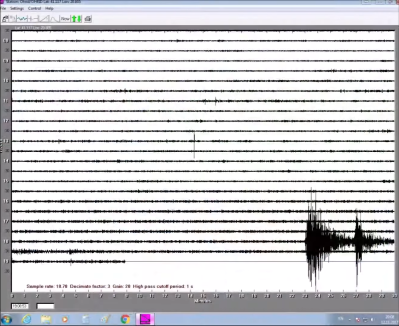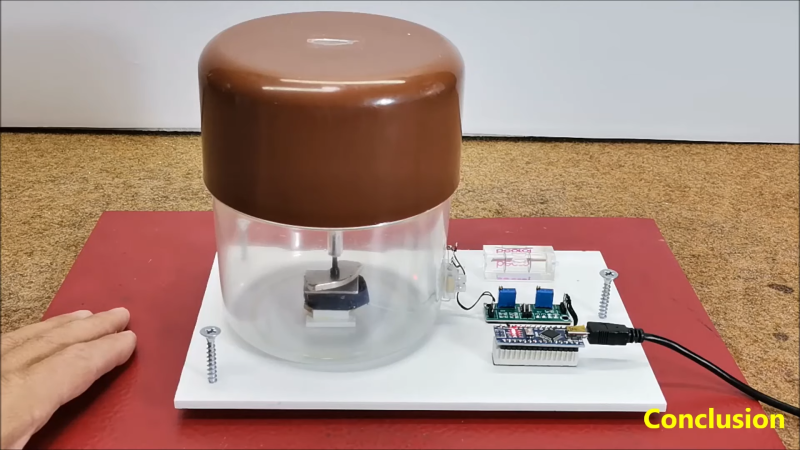If you’re a child, there are certain things you’re taught even though they’re probably not directly relevant to your life. We teach young kids all about dinosaurs, and we teach older kids all about how the mitochondria is the powerhouse of the cell. We also teach kids about natural phenomena like earthquakes, and the equipment used to measure them. Namely, seismometers. You might like to satisfy your own child-like curiosity by building one of your own, like [mircemk] did.

The build starts with a sensitive geophone of [mircemk’s] own design. That’s basically a microphone but it’s for picking up vibrations in the ground, not in the air. However, a geophone is not enough. You need to be able to pick up the signals from the geophone and then plot them if you want a seismometer.
First, the signals from the geophone must be amplified, which is achieved with a small circuit based around the LM358 op-amp. From there, the signal is sent to an Arduino where the output is captured via the analog-to-digital converter. This passes the signal to an attached PC which plots the results using a piece of software called NERdaq, which was developed for schools that built their own slinky-based seismometers.
[mircemk] reports that this setup has served as a reliable tool for visualizing earthquake activity for over 6 years. Though, it bears noting, it’s not calibrated so don’t expect to get science grade results out of it. Regardless, though, it’s a super cool way to understand more about what is going on with the geology around us. Video after the break.

















I have a strong sense of deja vu.
https://hackaday.com/2024/03/02/diy-geophone-build-performs-well/
Same author, no less. Looks like he wasn’t quite finished with the article on the last post!
Well, the article linked to it, so maybe Mr. Poirot ne voyait pas the content? It’s another video with an update.
This is what happens when content is paid on a per-article basis; cf. perverse incentive.
To repeat the problems with this (and amplify* others’ comments):
________
“Fun project but you’d get better results with an accelerometer chip.
All issues with signal conditioning aside, the low resonant frequency of the spring-mass system is going to be problematic in terms of producing useful quantitative data. Spurious resonances are a known problem/phenomenon in this realm and it can be compensated/adjusted but you have to know it’s there. Like most mechanical accelerometers, any kind of low fn input gives a wildly amplified result, whereas high frequency may be damped completely by the mechanical impedance mismatch.”
________
*You saw what I did there.
Unfortunately, accelerometer chips have a drastically lower sensitivity, and stronger noise. I am practically confident in that, and if you are interested, you can look at my previous projects
At best this is a seismoscope and not a seismometer. This device is free to move in any direction and looks not to be damped at all. Geophones have one degree of freedom and at that very least are daped be the captive in the case. All you can do with this is see squiggey traces. Geophones are quite cheap so the while the material cost is next to nothing the results are nowwhere near as good.
Ok, but this is still the simplest way to detect tremors. After all, the seismograms from the local seismological station in my city are almost identical to those of this simple instrument. Of course, my instrument is not intended for the analysis of the received data, but only for visual confirmation of the earthquake.
This creeations is a seismoscope and not a seismometer. It looks like can move in ANY direction and undamped. Geophones are limited to one degree of freedon and at the very least are damped by the air in the sealed case. Whlile the material to make this cost next to nothing the output will just be a squiggly trace where you will not be able to see a distinct separtion between the P and S waves. Geophone are quite afordable.
Thanks for sharing, this is a fun project and I was looking at doing something like that! I will inspire from what you did and try to build one like that here in Japan.
Sure I won’t “measure accurately” the tremors here, I’m sure no-one could think that 3 USD of scrap material would compare to any dedicated tool. But it can be fun to view and record them by myself, or to show to the kids so they understand.
Don’t listen to the trolls, it’s cool what you did. Thanks for sharing again.